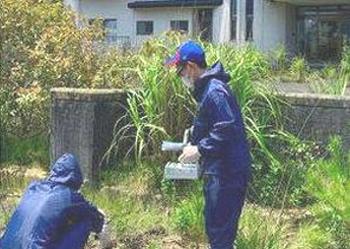
FUKOKA, Japan, October 22, 2019 (ENS) – The distribution, number, source, and movement of radioactive microparticles in the environment following the 2011 Fukushima Daiichi nuclear meltdown has been poorly understood, but new research from an international team of scientists has produced a way for researchers to quantify the amount of cesium-rich microparticles in soil and sediment samples.
A 9.0 magnitude earthquake and resulting tsumani that struck Japan on March 11, 2011, started the nuclear meltdown at TEPCO’s Fukushima Daiichi nuclear power plant, the worst nuclear incident in 25 years. It displaced 50,000 households after radioactive material leaked into the air, soil and sea. Radiation checks led to bans on some shipments of vegetables and fish.
The release of radioactive isotopes from reactor containment vessels at Fukushima Daiichi was a result of venting in order to reduce gaseous pressure, and the discharge of coolant water into the sea. This resulted in Japanese authorities implementing a 30-km exclusion zone around the power plant and the continued displacement of approximately 156,000 people as of early 2013.
Large quantities of radioactive particles from the incident, including iodine-131 and cesium-134/137, have since been detected around the world. Substantial levels have been found in California and in the Pacific Ocean.
The released radioactivity included small, poorly soluble, cesium-rich microparticles. The microparticles have a very high radioactivity per unit mass (~1011 Bq/g), but their distribution, number, source, and movement in the environment has remained poorly understood.

This lack of information has made it hard to predict the potential impact of the radioactive microparticles.
But a study just published in the scientific journal “Chemosphere,” involving scientists from Japan, Finland, France, and the United States, addresses these issues.
The team, led by Dr. Satoshi Utsunomiya, Ryohei Ikehara, and Kazuya Morooka of Kyushu University, a prestigious research school in Fukuoka, Japan, developed a method in 2018 that allows scientists to quantify the amount of cesium-rich microparticles in soil and sediment samples.
They have now applied their method to a wide range of soil samples taken from within, and outside, the Fukushima Daiichi nuclear exclusion zone, and this has allowed them to publish the first quantitative map of cesium-rich microparticle distribution in parts of Fukushima region.
The map shows three regions of interest within 60 kilometers from the Fukushima Daiichi site
Dr. Utsunomiya said, “Using our method, we have determined the number and amount of cesium-rich microparticles in surface soils from a wide range of locations up to 60 km from the Fukushima Daiichi site. Our work reveals three regions of particular interest.”
“In two regions to the northwest of the damaged nuclear reactors, the number of cesium-rich microparticles per gram of soil ranged between 22 and 101, and the amount of total soil cesium radioactivity associated with the microparticles ranged from 15–37 percent,” said Dr. Utsunomiya.
“In another region to the southwest of the nuclear reactors, 1–8 cesium-rich microparticles were found per gram of soil, and these microparticles accounted for 27–80 percent of the total soil cesium radioactivity,” he said.
Professor Gareth Law from the University of Helsinki, a co-author of the study, said that the paper “reports regions where the cesium-rich microparticles are surprisingly abundant and account for a large amount of soil radioactivity.”
“This data, and application of our technique to a wider range of samples could help inform clean-up efforts,” Law said.
Utsunomiya said the work “provides important understanding on cesium-rich microparticle dispersion dynamics, which can be used to assess risks and environmental impacts in inhabited regions.”
The study’s authors found that the cesium-rich microparticle distribution was consistent with the trajectories of the major radioactivity plumes released from the Fukushima Daiichi site during the late afternoon of March 14, 2011, to the late afternoon of March 15, 2011.
This may indicate that microparticles only formed during this short period.
Utsunomiya says, “Based on the distribution and known sequence of events during the accident, our data suggests that reactor unit 3 was the most plausible source of the cesium-rich microparticles at the beginning of the release period.”

Reference:
Abundance and distribution of radioactive cesium-rich microparticles released from the Fukushima Daiichi Nuclear Power Plant into the environment, Ryohei Ikehara, Kazuya Morooka, Mizuki Suetake, Tatsuki Komiya, Eitaro Kurihara, Masato Takehara, Ryu Takami, Chiaki Kino, Kenji Horie, Mami Takehara, Shinya Yamasaki, Toshihiko Ohnuki, Gareth Law, William Bower, Bernd Grambow, Rodney Ewing, Satoshi Utsunomiya. 2019. Chemosphere, Volume 241, February 2020, 125019
https://doi.org/10.1016/j.chemosphere.2019.125019
Copyright Environment News Service (ENS) 2019. All rights reserved.
